There are many beautiful examples of sunken gardens to be found, but our own sunken garden, directly in front of the house, was not a consequence of intentional garden design.
When we were first considering purchasing this property, the most evident features of the property, other than the house itself, were the surrounding woodland, and the terrain. Where most buyers are usually concerned with the condition of the house, we were most concerned about the composition of the soils.
The woodland on the property was beautiful, but some parts of the property have very steep slopes, greater than 2:1 in some areas, and the soils are somewhat friable.
This is not an area to purchase property blindly. This region along California’s central coast has a history of significant mudslides, some of which, like the notorious Love Creek landslide in Ben Lomond on January 5, 1982, have resulted in significant loss of life and personal injury over the years.
We’d lived in the Santa Cruz Mountains once before, so we knew what the possibilities were with properties that have this sort of terrain. However, we wanted to be truly informed buyers, so we made our purchase of this property contingent on the results of a thorough geologic, and hazard assessment, which was performed by our own Geotechnical Engineer prior to the close of escrow.
This may sound overly cautious to some, but our own previous experiences living in this part of coastal California had taught us that the forces of nature in this area demand a certain level of respect. Earlier this spring there was a spectacular reminder of what Nature is capable of in this region, after saturating rains triggered this large rock slide.
While our engineer was busily compiling his report, our own inspections during escrow uncovered an area underneath the front deck, which was attached to the house, where it was clear the owners of the property had been adding large amounts of gravel and river rock over a period of time surrounding one of the deck’s support posts. Something seemed amiss.
There was no disclosure in the sale agreements regarding this finding, so the owners were questioned at length. They had already lost a previous potential buyer, and we threatened to halt the sale as a result of these findings.
The owners eventually admitted that this area had been sinking previously, but contended this had been in the past, and that they’d resolved the issue prior to listing the house for sale. Concerned they were telling us what we wanted to hear, as no potential buyer wants to hear that a property has a sink hole of unknown origin, we were wary of their response.
Our Engineer was independently asked for his assessment as to what might be going on under the deck. The problem was that there are many potential causes of sink holes. Subterranean geologic fissures, erosion due to underground springs, poorly packed fill, just to name a few, and the range of potential costs to repair the problem is just as varied, and often not covered by insurance.
After a number of sleepless nights, and digesting the evaluation by the engineer, we proceeded with the purchase, primarily because it was shown that the settling soil would not impact the house directly as the foundation was supported with numerous piers that were anchored to the bedrock below.
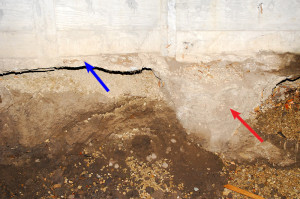
Even if the perimeter foundation wall was completely exposed (blue arrow), support piers, anchored 16 feet down in bedrock, are what actually support the house (red arrow)
At the end of the first year here it was becoming apparent that the ‘stable’ sink hole was anything but stable. Eventually the soils collapsed enough that the deck railings attached to the corner of the house separated, and there was a significant shift in the surface soil.
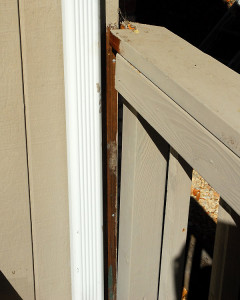
The first real evidence the ground was still sinking...the deck railing was pulling away from the house
By the second year the soils had moved so much, an entire section of driveway began to collapse.
This section of driveway was almost floating.
Holding the camera under the deck, and shooting toward the house, we also discovered the foundation wall was now fully exposed to the point that you could have put your entire arm underneath it.
As the area of soil collapse appeared to be rapidly expanding, we started by doing some more extensive surveying ourselves.
When the driveway tried to swallow an entire yard stick, we knew this situation had to be addressed, immediately.
We began by removing the broken concrete to see if there was anything immediately obvious. It was apparent however that with our own equipment we wouldn’t be able to excavate the area enough. It was time to call the experts, so we hired a team of excavators.
Before the excavators arrived, the deck was completely removed so they could dig down and find the source of the problem, unencumbered.
Our excavation contractor has many years of experience exploring the soils in this part of the Santa Cruz Mountains, and has many stories to tell of the things he’s seen over the years. He had his own suspicions as to what might be going on as soon as he saw the damage.
The first six feet of excavation revealed various strata composed of differing sizes and colors of rock, and gravel, even huge poured cement slabs. Having studied archaeology in college for a time, I was initially somewhat bemused by the various man made layers of materials that were exposed by the excavator.
However, my bemusement quickly turned to anger and frustration when it became evident the sellers of the property hadn’t been completely honest regarding the severity of the collapse in this area, nor were they honest about the extent of their own efforts to fix it.
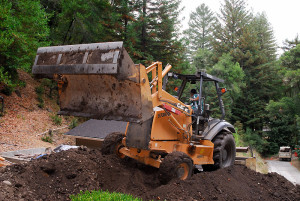
As much as we're willing and able to do projects around here, sometimes it's simply more efficient to call the experts
Half a day of digging, and we had an enormous hole in the front yard, but it wasn’t long thereafter, 10 feet below grade in front of the house, that we had our answer. Our excavator’s prediction was correct.
The lazy, unscrupulous builder of this house, rather than hauling the trees removed to make way for the house, had buried the enormous trunks and stumps 10-12 feet underneath the fill soil, and then poured the driveway over the top.
As angry and frustrated as we were at this builder though, we were actually relieved that we now had a better understanding of the cause of this sink hole, and could now address the problem, and fix it properly. Not knowing why the ground was opening up caused much more anxiety than formulating a plan to fix it.
The trouble was our wet winter last year, became a wet spring this year, and until the soils were thoroughly dried out, excavating the tree trunks and stumps would have to wait. Although we could pull the offending material out, the soils would not compact properly until they were dry. The exploration area was temporarily filled back in, for safety sake, and then yesterday, the excavators were able to return to clean up the mess left behind a quarter century ago by the the lazy builder.
Our crew really did a fabulous job, setting straight to the task of re-excavating this area. It was as if they’d done it a hundred times before, and apparently it seems they may have, as in this area at least, burying woody debris on the job site used to be very common.
It wasn’t long before the first substantial remnant tree roots were uncovered. Even though we’d seen evidence of some of this debris during the excavation in March, some of these stumps were even larger than the excavators had anticipated!
They struggled for some time to drag this massive root ball up and out of the hole…
…eventually, with team work, they succeeded.
That was just the beginning.
As the hole widened and deepened, three tires and an old inner tube were pulled out, and we half expected we’d find the vehicle they’d been attached to…thankfully though, there wasn’t one.
Sadly we didn’t find any buried treasure either…none worth keeping anyway.
All of the offending debris, with the exception of the tires, was old fir stumps, and decaying logs.
The trouble with fir, unlike the redwood here, is it rots much more quickly. As the wood decays, voids in the soil are created above the stump, and the ground collapses.
Deprived of oxygen underground, decay was slowed initially, but some 25 years later the rate of decay was significant enough to translate into a three foot drop in surface soil in just a couple of years.
A full day of excavating yesterday yielded more than 7 tons of smaller woody debris. That however doesn’t include the FOUR enormous rotting Douglas Fir root balls that were hauled out.
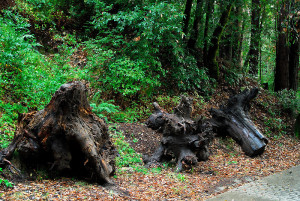
These stumps, removed from the front garden area yesterday, will need to be sectioned before they are loaded on the truck and removed
These were so large, that the contractors have had to return today so they can partition these root balls with chainsaws so they will fit in the dump truck to be hauled away. None of the heavy equipment they brought was capable of lifting the stumps intact into the back of the truck.
Although this has taken a substantial amount of resources to remove this material, it would be far more expensive to landscape the front area of the house, and repair the driveway, without fixing the source of the problem. The previous owners had tried that to no avail.

Not quite the look we're going for in front of the house, but without this equipment we'd never have been able to resolve this problem
We were somewhat thwarted on regrading some of this area last night due to the first substantial rainfall of the season, which has temporarily turned the front of the house into a mud pit after 0.66 inches of rain fell. There’s more rain on the way tomorrow, but as the garden needed the water, we can’t complain.
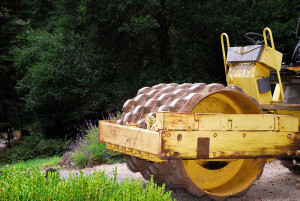
Once the soil dries out from last night's rain, this compactor will finish grading and compacting the area that was excavated
However, by early next week our contractors will return to finish the grading in this area.
Before they return we have some irrigation repairs to do, as one casualty of yesterday’s excavation was the main irrigation line that leads out to the orchard was severed. Compared to the sink hole, that’s a minor repair.
With the offending woodland debris now removed, we’ll be able to finally move forward with re-landscaping the front garden area, and replacing the damaged driveway, with the knowledge that this sink hole is finally repaired.
In the meantime it’s time to brainstorm ideas for the new design for the approach to the house. This time though, I can say with unwavering confidence, we are not planning to install another sunken garden.

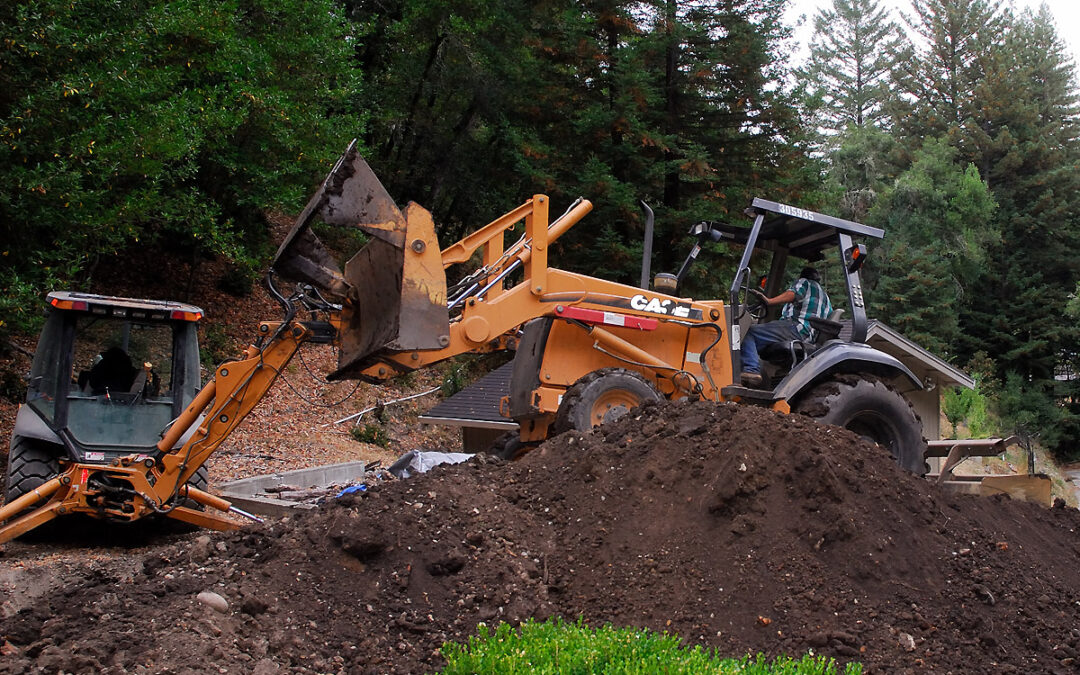
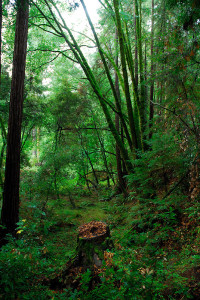
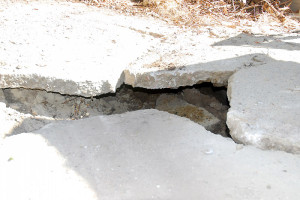


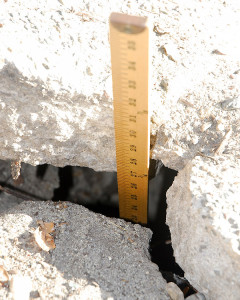

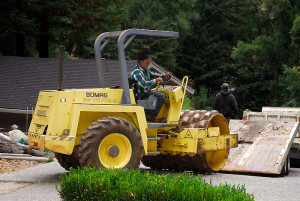
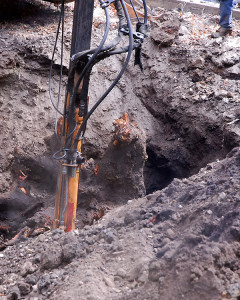
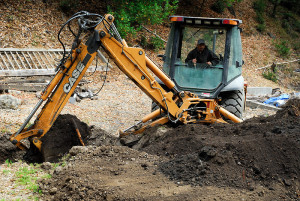
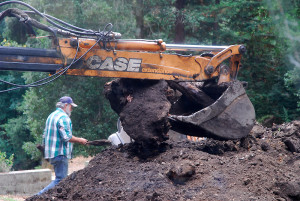
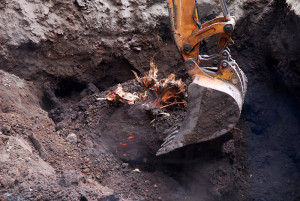
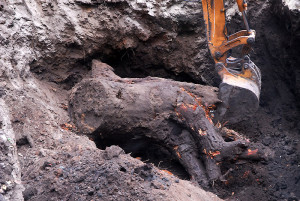
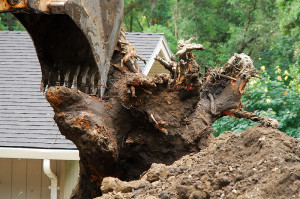
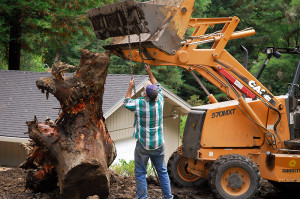
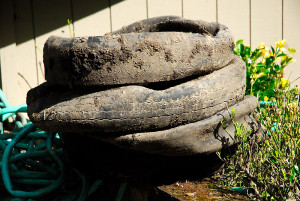
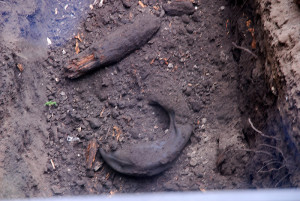

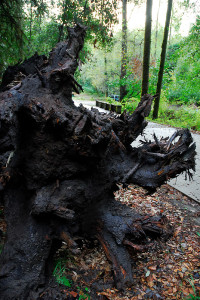
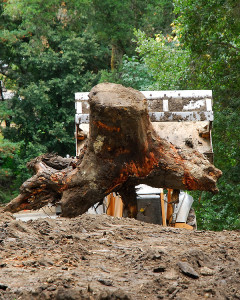
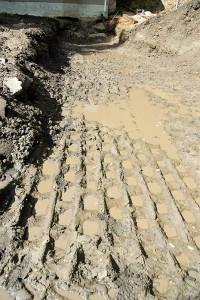







Clare,
What a mess, glad you got it taken care of. The builder was likely not smart enough to know that burying stumps under a roadway would cause a problem. Not many think long term anyway. I see all kinds of stuff I’d not dream of doing on 25-35 year old houses in my work as a handyman.
You’re kinder than me Randy, I assume the builder knew exactly what he was doing. He also knew he’d be long gone before there was evidence at the surface. Not all builders are bad, but bad builders are infuriating! 😉
What an ordeal, one that should never have occurred. I can not tell you how many times I have either uncovered or caught contractors in the act of burying debris. They know exactly what will happen, but it occurs long after they are long gone. What is even worse it the chemicals they bury, all highly illegal of course. It then is left to leach into the soil and contaminate. It costs them money for proper disposal, and burying it on site saves them a bundle in transport and disposal fees.
I agree, the builders know what they’re doing when they bury materials on site. I’ve never seen anything to this extent, personally, but I’ve watched enough home improvement shows on TV to have seen similar builder-induced sink hole nightmares. I think the oversight now, as part of the construction permit process is more strict, and builders would have a difficult time getting away with it here now. Ironically, back then, it was probably much cheaper, or free, to dispose of this material appropriately. It’s expensive now (as we found out just with the first 7 tons). I know why builders do it, it’s all bottom line, but it certainly doesn’t make it right.
Heavens! I first thought, ‘How nice,… a sunken woodland garden!’ Then I realized I was reading about a whole other thing, one that no one wants to write about. Having our house on a 16 degree slope I can surely empathize, Clare. What a challenge!
Sounds like you had expert help and never would have known what the situation truly was at the time of the sale. It took us a full year to grade and add drainage lines to our house pad and parking area. The county doesn’t make it easy either. Hope all is well from here on out!
A sunken woodland garden does sound lovely, one that was planned, designed, and appropriately installed 😉 My alternate title was going to be “SINK HOLE: The Legacy of a Lazy Builder”, maybe I should have run with that. Drainage will be a big part of the upcoming project to re-landscape this entire area, and I’m sure our own county permitting process for that will slow things down too. Part of the plan will be a more permeable driveway surface to mitigate run-off, if we can find one that’s durable enough, not toxic, and stable on a steep slope. Again, I wish I could fast forward and see how this all turns out!
You’ll do great, Clare, what ever you decide! Several layers of road base and 3/4 inch crush is what we’ve used but it does taking yearly grooming.
Hi Clare,
What an awful discovery! developers are just terrible and as sad as it sounds; it doesn’t surprise me that this has happened – which in itself speaks volumes.
I hope the problem is totally sorted now and you can have fun redesigning the area 🙂
Honestly, I’m not sure I was surprised either. Relieved that it wasn’t a geologic hazard that needed mitigating, but not surprised. The redesign will certainly be a challenge. We have variable terrain, both sunny and shaded areas, and need the design to be practical and functional (for cars and parking), but aesthetically appealing as well, as it’s the area in front of the house. Oh, and then there’s the deer. Factoring a deer-proof garden into the plan…that may prove to be the greatest challenge of all!
Gosh…what a drama…hopefully the problem is resolved for good now and normal life can resume.
I hope that’s the last of this builder’s mess we’ll have to deal with too. I’m looking forward to moving forward with a plan! 🙂
How awful…it is one thing to have a problem, but another to be lied to or misled about the issues. Thank goodness you found the cause so it could be fixed. Amazing the issues lazy people cause and the extra work they create for us to fix their mistakes. Glad to hear you are making progress and moving forward…
I agree, lazy people who depend on others to clean up their mess, are absolutely infuriating. In the previous owner’s defense, which is somewhat difficult as they did lie about a number issues related to the house, it’s obvious they didn’t know the underlying cause. I suspect, like us, they were somewhat scared to pursue it, for fear of what may be uncovered, and the associated expense. However, ignoring it wasn’t productive either, and honestly, with as quickly as the ground was settling, it clearly would have impacted the property value, heavily, if left unresolved. They likely spent much more time shoveling gravel into an ever-widening hole, than we did fixing it. Overall, spending 3 days to fix this mess, and some dollars, was more than worth it for peace of mind. 🙂
I’m reading your essay with a bad head cold, so maybe I’ve missed this detail…
What’s under the actual house? More of the same?
Oh, sorry Lisa, no it’s not your foggy cold-laden head (I hope you’re better soon), I didn’t make that clear. Underneath the house, except for a drainage issue behind the house from a French drain, that we’re also fixing, the ground appears stable. The house is fine as there are multiple 16 ft piers under the foundation, but the soils under the house don’t appear to be sinking. This whole hole was approximately 30 feet wide and 50 feet in length just forward of the foundation, between the house and the workshop. If it was under the house, I can’t imagine how impossible it would have been to fix! 😯
Whew! That’s good news, anyway!
What an ordeal! I’m just glad to got that taken care off before the rainy season, and that the house seems to be on solid ground. We once looked at a house near Big Sur that was half on top of a redwood stump. Sure. it was redwood, but even that will rot.
Hope the rains were gentle to you.
Haha! Well, nature got the last laugh. We waited so long to start this project because we’d had late rain this spring, and then the day the crew shows up, it rains. Last night’s rain was another 1.25 inches since midnight, and as the additional fill soil hasn’t yet been brought up to level the grade, we have lake Curbstone outside the living room window this morning 😉 Next week looks dry though, and yes, it will be great to wrap this up before the rainy season shows up in earnest. On the upside though, the rains mean I can get more serious about fall planting!
Bet your lab could put that lake to good use.
Other friends have found unusual holes in their yards, but none quite like this one.
Clare that must have been quite a concern for you at first not knowing what was causing those holes. I’m sure you are looking forward to redesigning the front garden but I can just imagine the mess there is just now especially after all that rain you’ve had.
I admit, it was somewhat stressful the day of the initial exploration in March, wondering what on earth they would uncover, and how much it would cost to fix it. As insurance generally doesn’t cover mudslides and sink holes, we had no idea if we’d end up paying for this for years to come. Trusting our Geotechnical Engineer, that it was unlikely to be geologic in nature, only gave us so much peace of mind. Finding the cause was a huge relief.
It is a little muddy out there at the moment though! We had to move the dog’s potty spot. The dogs (a lab and lab-cross) have that extra webbing between their toes that loves to hold on to mud just long enough to get it all over my kitchen floor! 😛
What an unexpected expense! I wonder if the sellers knew what the problem was – they were probably just glad to get rid of a problem they could never figure out. Actually, I’m glad it wasn’t something worse – like an underground spring or something that couldn’t be excavated and repaired. Still, all that money – down a hole!
I know the sellers were relieved they didn’t have to deal with it. They knew it wasn’t fixed. They seemed reasonably desperate to sell. Perhaps if we’d pushed harder they may have conceded to explore it further, who knows, although I doubt it. That’s the part of home buying I hate, the psychological war-fare component that goes with it. In California there is still legal ground for compensation after a sale for issues that weren’t sufficiently disclosed, and exploration did stop for a while in March. Our contractor needed to know if we intended to pursue legal action against the sellers for compensation related to the cost of repair. Not for payment, but because it would alter how the excavation was conducted. It’s foolish for sellers to be dishonest in this State. If everything is disclosed, up front, in writing, and agreed on a the time of sale, there’s no recourse for the buyer. They were lucky, this time. You’re right though, that is an expensive hole! 😀
While I’m very sorry that you’ve had to deal with all that, your post was really interesting and I’m thankful for the education it provided. I’ve got a bit of a sink hole in my front yard as well – no where near the scale or the danger of yours, however. As far as I can tell, an old mulberry tree was cut off at the ground and the roots were left where they were to rot. Someone might twist an ankle if they step in the wrong spot but that’s better than having your house slide into a pit.
By the way, that video was amazing!
Even small sink holes can be frustrating though, especially when the soil continues to settle. If your mulberry stump isn’t too large, it might be worth trying to dig it out. At least then you can plant something there, and not worry about it disappearing under ground 😉
What a saga – no legal comeback on such cavalier cowboy behaviour?
There could be, but honestly, at this point, I think I’d rather chalk it up to experience, and divert my energy toward improving and re-landscaping the garden, than giving myself ulcers negotiating with lawyers.
My, what an ordeal! However, you were very wise to go ahead and dig for an answer. We live on a slope, and after the hurricane some county residents suffered the damage of a sinkhole. We are grateful we have not suffered such a tragedy, and I hope we never do. Good luck!
I’m glad we excavated. I’m a ‘need to get things done and move on’ sort of person. Watching the ground continue to sink for years to come would drive me crazy! 😉
What an ordeal! I hope you plan to pursue a claim against the seller. You certainly attempted to do due diligence in evaluating this property (and reading about the mudslides from time to time, i can well appreciate why!). But when someone is deliberately dishonest, even an expert can be led to make an incorrect assessment if they don’t have an accurate report of what has happened.
Good luck with the regrading and eventual rebuilding of a garden. I can’t even imagine the cost. The little bit that we had to do to prepare our relatively flat property approached five figures. This was far more extensive… and those stumps and root balls… that wasn’t just lazy, putting those in the fill in that area was criminal!
This was an expensive repair, but in the long run the effort to repair it will be worth it. In some respects I’m looking forward to re-designing the garden here, and with the slope our driveway has been awkward, with a very tight place to turn around. I think we can expand that, but also make the garden area much more attractive too. It won’t happen overnight, but in my mind’s eye it should turn out to be quite an improvement!
Out of sight, out of mind was the thinking I suppose. Reminds me of some of the stories around here with field stone foundations and cracks.
I think that’s a common mode of thinking, at least with some builders. Besides, it’s not their property, as long as they get paid, what do they care?!
I think you should save the stumps and have a stumpery. Prince Charles has one and so does the Morris Arboretum in Philadelphia. They are very in and very beautiful.
Interesting thought Carolyn. We do leave most of the stumps, and sometimes even whole trunks in place when we fell dead trees, as they make for excellent habitat for our lizards and salamanders. My only concern with these stumps is that now they’re exposed to oxygen, they’ll decay very rapidly. One of the oak trunks we pulled out in March during the initial explore was rotting very quickly. Otherwise I think a stumpery sounds like a lot of fun, and I agree, the stumps are quite beautiful!
Those stumps might make a great mushroom farm!
Seems less like laziness and more like greed. As you have found, dealing with the stumps was expensive, although more now than it would have been for the builder. If the people you bought from weren’t the initial owners they may not have known what was causing the sinking I suppose. But the builder was just helping his bottom line. I am impressed with the power of greed. (Mostly I am impressed with how some with so much income seem to need more all the time, like increased doses of a drug.) So sorry for all you’ve been through, but you will make it beautiful and better and never have to wonder and worry about it again!
The previous owners were the only owners of the house, but the builder constructed the house on spec, and then sold it once construction was complete. The dead trees were likely buried before the prior owners first saw the house. I don’t believe the previous owners knew what was causing the sink, specifically, but they did know it was sinking, had been for years, and was continuing to sink. They told us it was minor, and it was fixed, but it didn’t take a genius to see that throwing large rocks into a hole wouldn’t be the right solution to repair a sink hole. They weren’t honest about the fact it was an ongoing problem, but that said we accepted it may not really be repaired just based on what we saw, and proceeded with the purchase. To my mind the real blame lies with the greedy and lazy builder who buried the debris.
Holy cow, what an undertaking. Any hopes of recovering anything from the previous owners? Contractor’s long gone, I’m sure.
I agree, if the contractor had any sense, he’d be living under an assumed identity by now 😉 We could pursue litigation with the prior owners, but honestly, life is too short, and it would likely cost more in time and attorney’s fees to chase after them, than it probably cost to just suck it up and fix it. On the upside, it was a strong point of financial negotiation during the sale, so in that sense the cost has been covered.
What a mess! After reading the comments and your replies above, I’m encouraged by your attitude. Sounds like you are taking it all in stride as best you can. It’s a refreshing perspective.
Wow. That’s quite a story. Sorry to hear about all that. But maybe you’ll end up with a better approach to your house, gain some positive out of everything. It sounds like you can make the new area into whatever you want.